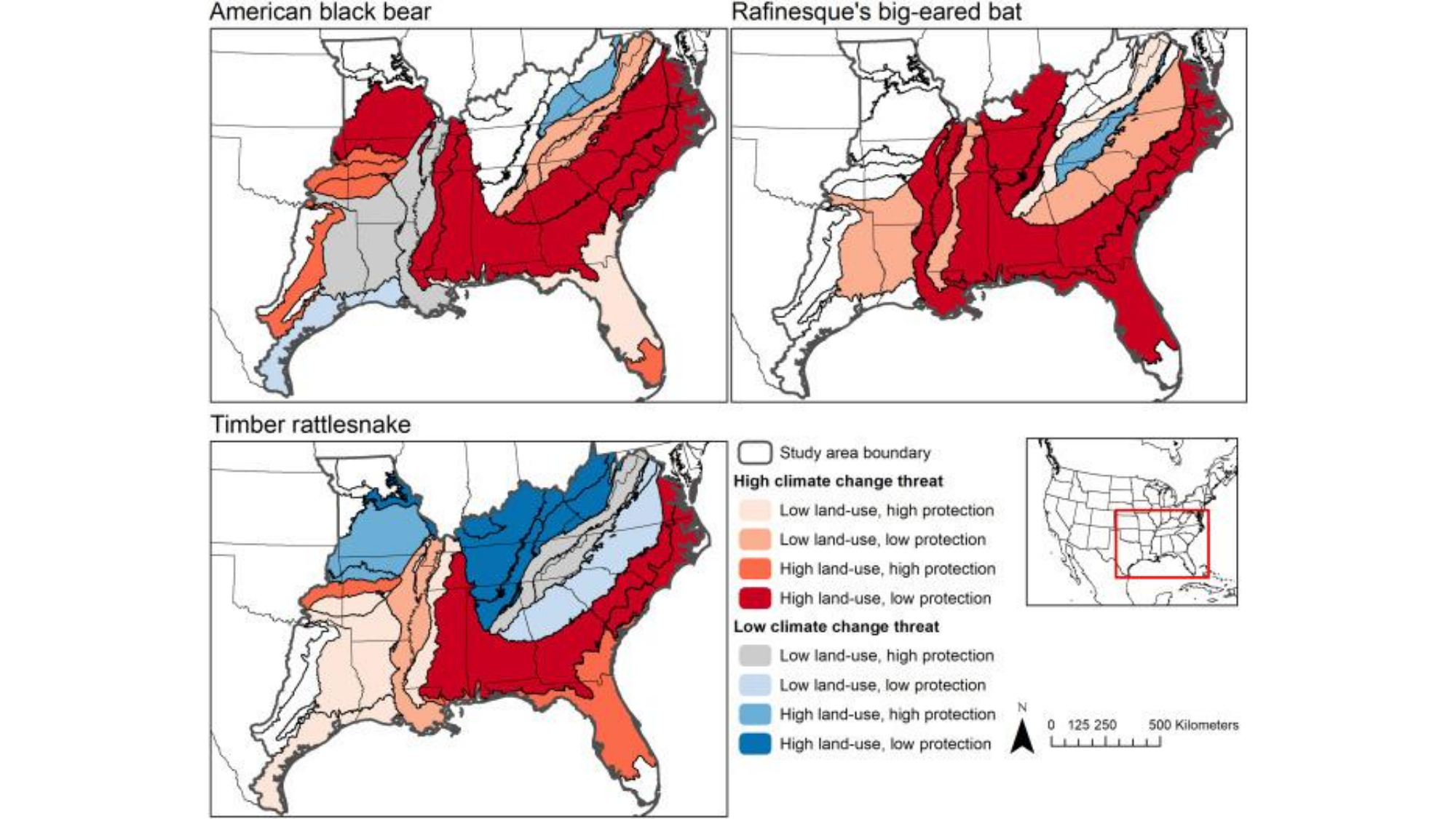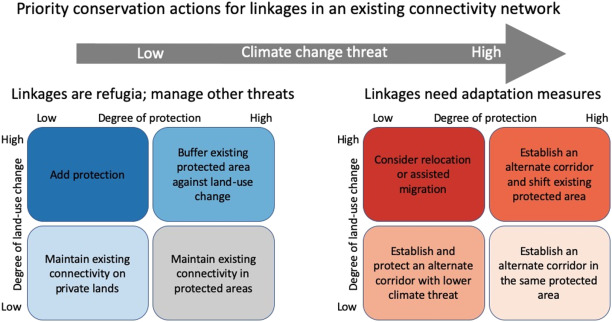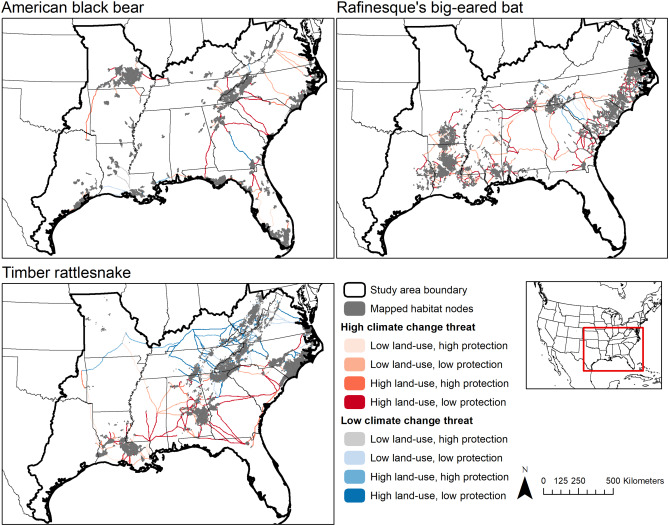Conservation Priorities Will Vary as Climate and Land Use Changes

A new article led by SE CASC Researcher and Faculty Affiliate, Dr. Jennifer Costanza, “Preserving connectivity under climate and land-use change: No one-size-fits-all approach for focal species in similar habitats,” was released in the August 2020 edition of the journal Biological Conservation. This work was supported by the SE CASC project, Understanding Habitat Connectivity to Inform Conservation Decisions. The following post was written by SE CASC Science Communications Specialist, Ashlyn Shore.
Conservation priorities for species that currently occupy overlapping habitat networks will vary for each individual species under the threat of climate and land use change in the southeastern United States.
While at NC State University, Dr. Jennifer Costanza and a team of researchers from multiple organizations investigated the climate and land-use change threat to existing habitat networks for three focal species – the American black bear, the Rafinesque’s big-eared bat, and the timber rattlesnake. While the three species currently occupy similar habitats, the emerging threats of climate and land-use change will alter their respective suitable habitat regions, so knowing how much and where in the region each species is likely to be threatened by climate and land-use change will be critical for conservation planning. However, scientists currently have little understanding about the degree to which species that use similar habitats will experience similar climate and land-use change threats. Thus, Costanza and her team sought to fill that gap by asking: Will those threats play out similarly for all three species in the future? And what might future threats mean for conservation of these species?
To find out, the research team mapped each species’ existing habitat network, or the layout of connected land that allows a species to move across the landscape. Habitat connectivity is the degree to which these networks are connected and is essential to maintaining populations of these species, especially as the climate changes. Within those networks, they identified which linkages, or connections between habitat patches, that were most important for each species’ existing habitat network. Then each important linkage was classified by whether it had high or low threat from future climate and land-use change by 2050, and what proportion was currently a protected area managed for conservation.
Researchers used those attributes (climate and land-use change threat, protection status) to classify linkages for each species according to the suggested conservation actions for maintaining connectivity (Figure 1). For example, some areas in a species’ range may remain more climate-stable compared to the rest of the landscape. Those regions can serve as ‘climate refugia,’ and conservation actions can focus on managing non-climate threats. In other cases, a high threat of climate change to an existing linkage may require adaptation measures such as assisted migration or the introduction of an alternative linkage for a species.

Costanza explains that “In conservation, we often don’t have specific information about habitat threats from climate or land-use change for a particular species. So, I think it’s common for conservation plans to assume that similar species would benefit from the same conservation actions.” She adds that “this study was really exciting because we were able to show a case where that doesn’t hold up – species we expected might have similar threats vary quite a bit, and they need to be considered separately in conservation planning.”
For the three identified species, researchers mapped linkages based on recent climate and land-use conditions and evaluated the climate threat to these linkage networks by 2050. Additionally, they evaluated the degree of land-use change and protection status for the most important linkages in the network. The Southeast was an ideal area for this case-study, as multiple ecoregions and varying degrees of threat are present in this zone. The degree, or velocity, of climate change is expected to be high in the coastal plains and low in mountainous areas, and extensive urbanization is projected for the Piedmont region.
While the three focal species currently use similar habitats, they will experience varying degrees of threat from climate and land use change by the year 2050. More specifically, the Rafinesque’s big-eared bat faces a high degree of threat from climate change to its network as a whole. Almost half of the important linkages for the bat had high climate change threat, high land-use change threat, and low protection status, making it clear that conservation measures outside of its natural habitat should be a priority. The American black bear is projected to see the smallest change in suitability across its whole network, but similar to the bat, almost one-third of the important linkages are under high climate and land-use change threat with a low degree of protection. In this case, the protection of an alternative corridor should be of conservation importance. The timber rattlesnake will experience a moderate decrease in habitat suitability overall, though many of the rattlesnake’s linkages can serve as climate change refugia, as they reside in mountainous areas and have only a low climate-change threat. Regardless, these regions are under higher land-use change threat and also have a low degree of protection, revealing the importance of increasing protection status for those linkages.

Each of the three focal species varies in the degree of climate change threat, land-use change threat, as well as protection status and thus, varying conservation protection measures will need to be taken in order to maintain habitat connectivity in the Southeast. While the three species currently occupy similar habitat networks, this study indicated that there is no one-size-fits all approach for connectivity conservation as the climate and land-use measures change. Researchers emphasize the importance of acting quickly, before these changes occur, to ensure the success of conservation actions.
The paper, Preserving connectivity under climate and land-use change: No one-size-fits-all approach for focal species in similar habitats, is published in the journal Biological Conservation. Authors are Jennifer Costanza (NCSU), James Watling (John Carroll University), Ron Sutherland (Wildlands Network), Curtis Belyea (NCSU), Bistra Dilkina (University of Southern California), Heather Cayton (Michigan State University), David Bucklin (University of Florida), Stephanie S. Romañach (USGS Wetland and Aquatic Research Center), and Nick M. Haddad (Michigan State University). The work was supported by the Southeast Climate Adaptation Science Center project, Understanding Habitat Connectivity to Inform Conservation Decisions through Grants no. G12AC20503 and G16AP00129 from United States Geological Survey.
- Categories:
